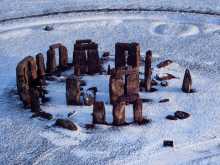The large sarsens, or henge stones, are so named for the two enormous standing stones that support the lintel, or smaller top stone that’s braced across it. It’s unclear how early people were able to lift the massive stones, which way many tons, to brace them across. However, it is believed that the sarsens were quarried from the Marlborough Downs, just 20 miles north of the Stonehenge site.
More perplexing is the recently discovered birthplace of the “bluestones”, which are also enormous but that were placed 1,500 years before the sarsens and rest in the innermost “horseshoe” at the center of the circle. According to geologists Robert Ixer and Richard Bevins, the bluestones originated in a 65-mtere long outcropping in North Pembrokeshire. The out-cropping, which is called Craig Rhos-y-Felin near the Pont Saeson, is 160 miles from the Stonehenge site in Wiltshire. The determined this through a pain-staking process of petrography, comparing mineral and textural relationships between rocks. Though it took nine months to triangulate the original home of the bluestones, it’s still unclear how a Neolithic people managed to move such massive stones such an incredible distance.
There are several theories as to how this happened. One promotes the idea that these primitive people did find some way of transporting the stones, such as using a series of wide, shallow-bottom boats and sledges. Another includes going overland with a series of logs that the stones were rolled across, similar to how Egyptians moved their quarried stone overland. The other idea is that the stones were actually moved by glaciers millennia before and were deposited on the site, the opportunistic people simply carved the stones and stood them on their ends.
According to Wired Science, Ixer and Bevins hope to discover when and how the ancient people took the stones on their 160 mile journey by discovering the exact pieces of bedrock from which the stones were removed.
